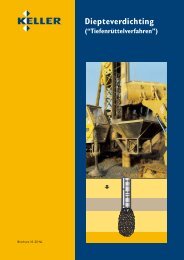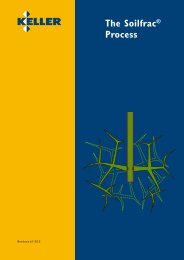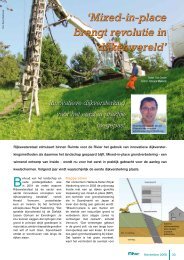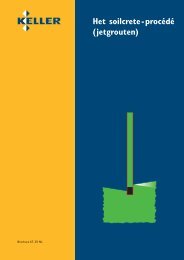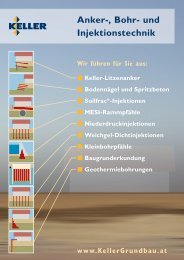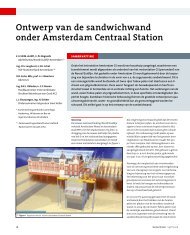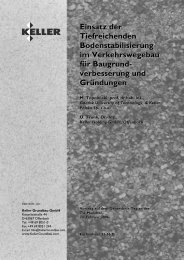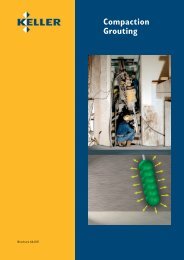Design and validation of jet grouting for the ... - Smet-Keller
Design and validation of jet grouting for the ... - Smet-Keller
Design and validation of jet grouting for the ... - Smet-Keller
You also want an ePaper? Increase the reach of your titles
YUMPU automatically turns print PDFs into web optimized ePapers that Google loves.
<strong>Design</strong> <strong>and</strong> <strong>validation</strong> <strong>of</strong> <strong>jet</strong><strong>grouting</strong> <strong>for</strong> <strong>the</strong> Amsterdam Central Station<br />
\ Figure 6 Principle <strong>of</strong> hydrophone measurement<br />
waves matches <strong>the</strong> passage <strong>of</strong> <strong>the</strong> <strong>jet</strong> <strong>and</strong> thus<br />
<strong>the</strong> diameter can be proved. It is also possible to<br />
adjust <strong>the</strong> <strong>jet</strong> <strong>grouting</strong> parameters if <strong>the</strong> results<br />
<strong>of</strong> <strong>the</strong> hydrophones are not conclusive thus <strong>for</strong><br />
example <strong>the</strong> lift speed can be reduced or<br />
increased <strong>and</strong> <strong>the</strong> response on <strong>the</strong> hydrophones<br />
noted. It is <strong>the</strong>re<strong>for</strong>e possible to match <strong>the</strong> <strong>jet</strong><br />
<strong>grouting</strong> parameters to <strong>the</strong> required diameters<br />
more efficiently.<br />
Spoil Density Measurements<br />
In addition to <strong>the</strong> use <strong>of</strong> <strong>the</strong> column calliper<br />
<strong>and</strong> <strong>the</strong> hydrophones, <strong>the</strong> density <strong>of</strong> <strong>the</strong> spoil<br />
returns from <strong>the</strong> borehole was measured at 1 m<br />
intervals during pre-cut <strong>and</strong> <strong>jet</strong> <strong>grouting</strong>.<br />
In principle this is a very low cost option <strong>for</strong><br />
diameter measurement as it does not delay <strong>the</strong><br />
operation <strong>and</strong> is simple to carry out. At Central<br />
Station a number <strong>of</strong> methods were investigated<br />
including hydrometers <strong>and</strong> mud balances.<br />
The interpretation <strong>of</strong> <strong>the</strong>se was found to be difficult<br />
if <strong>the</strong> highest accuracy was required <strong>and</strong><br />
finally a sample was measured by filling a<br />
\ Figure 8 Results <strong>of</strong> a diameter measurement<br />
\ Figure 7 Hydrophone measurement display<br />
1 litre container <strong>and</strong> using a digital balance to<br />
weigh it. At a later stage a 1 litre container<br />
with a close fitting lid was manufactured to<br />
give more repeatability <strong>of</strong> volume. The <strong>the</strong>ory<br />
<strong>of</strong> relating spoil return density to column diameter<br />
has been reported in a number <strong>of</strong> papers<br />
(Kauschinger et al. 1992) <strong>and</strong> (Croce & Flora<br />
2000). Essentially a mass balance approach is<br />
adopted to <strong>the</strong> material within <strong>the</strong> <strong>jet</strong> grout<br />
body <strong>and</strong> <strong>the</strong> excess material ejected from <strong>the</strong><br />
borehole. Assumptions are made that ei<strong>the</strong>r<br />
<strong>the</strong> column composition is identical to <strong>the</strong> spoil<br />
ejected or that certain percentages <strong>of</strong> <strong>the</strong> original<br />
material are retained within <strong>the</strong> column.<br />
Usually <strong>for</strong> s<strong>and</strong>s <strong>the</strong> first relationship is used<br />
but as larger particles or clay are present <strong>the</strong>n<br />
<strong>the</strong> mass balance approach becomes more complex.<br />
Figure 8 shows <strong>the</strong> results <strong>of</strong> a measurement<br />
by both spoil density <strong>and</strong> column callipers<br />
<strong>for</strong> a column. Because <strong>of</strong> <strong>the</strong> overlap <strong>of</strong> <strong>the</strong><br />
column with previously constructed columns,<br />
<strong>the</strong> calculation <strong>of</strong> spoil density is more complicated<br />
as an assessment <strong>of</strong> <strong>the</strong> actual column<br />
volume being cut is required. For <strong>the</strong> perimeter<br />
columns <strong>the</strong> areal percentage cut was around<br />
80-85 % whereas <strong>for</strong> <strong>the</strong> infill columns this<br />
ranged from 40-55 %. This change in column<br />
volume has a pr<strong>of</strong>ound effect on calculation <strong>of</strong><br />
spoil density or conversely back calculation <strong>of</strong><br />
diameter <strong>and</strong> if a truly accurate solution is<br />
required <strong>the</strong>n an iteration between adjustment<br />
<strong>of</strong> areal percentage <strong>and</strong> predicted diameter is<br />
required. However <strong>the</strong> results can give an indication<br />
<strong>of</strong> column diameter to within 20 %.<br />
Conclusions<br />
Significant advances have been made in<br />
Amsterdam in improving <strong>the</strong> quality control <strong>of</strong><br />
<strong>the</strong> <strong>jet</strong> grout process. The use <strong>of</strong> column callipers,<br />
hydrophones <strong>and</strong> spoil density measurements<br />
all give confidence to <strong>the</strong> actual diameter<br />
<strong>of</strong> <strong>jet</strong> grout column produced <strong>and</strong> it is<br />
expected that with fur<strong>the</strong>r development in all<br />
three techniques a better accuracy can be<br />
obtained. The use <strong>of</strong> a two stage process <strong>of</strong> a<br />
pre-cut <strong>and</strong> <strong>jet</strong> grout phase allows <strong>the</strong> separation<br />
<strong>of</strong> column diameter creation <strong>and</strong> column<br />
strength. It is considered that this approach<br />
will allow <strong>the</strong> use <strong>of</strong> higher design strengths in<br />
clays than was previously considered.<br />
References<br />
[1] Wit, J.C.M. de, Bogaards, P.J., Langhorst, O.S.,<br />
Schat, B.J., Essler, R.D., Maertens, J., Obladen,<br />
B.K.J., Bosma, C.F., Sleuwaegen, J.J., <strong>and</strong> Dekker,<br />
J. (2007), <strong>Design</strong> <strong>and</strong> construction <strong>of</strong> a<br />
metro station in Amsterdam, challenging<br />
<strong>the</strong> limits <strong>of</strong> <strong>jet</strong> <strong>grouting</strong>. Proc. 14 th Eur. Conf.<br />
on Soil Mech. <strong>and</strong> Geot. Eng. 24-27 September<br />
2007, Madrid, to be published<br />
[2] Kauschinger, Hankour, <strong>and</strong> Perry (1992 )<br />
Methods to estimate Composition <strong>of</strong> Jet<br />
Grout Bodies. Proc. ASCE Conference Grouting,<br />
Soil Improvement <strong>and</strong> Geosyn<strong>the</strong>tics,<br />
New Orleans<br />
Geotechniek ECSMGE<br />
21



